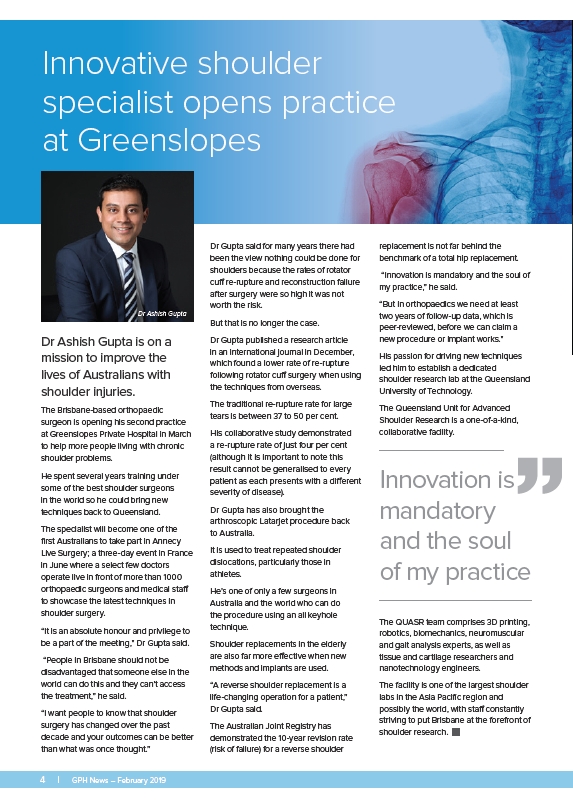
Innovative shoulder
specialist opens practice
at Greenslopes
Dr Ashish Gupta
Dr Ashish Gupta is on a
mission to improve the
lives of Australians with
shoulder injuries.
The Brisbane-based orthopaedic
surgeon is opening his second practice
at Greenslopes Private Hospital in March
to help more people living with chronic
shoulder problems.
He spent several years training under
some of the best shoulder surgeons
in the world so he could bring new
techniques back to Queensland.
The specialist will become one of the
first Australians to take part in Annecy
Live Surgery; a three-day event in France
in June where a select few doctors
operate live in front of more than 1000
orthopaedic surgeons and medical staff
to showcase the latest techniques in
shoulder surgery.
“It is an absolute honour and privilege to
be a part of the meeting,” Dr Gupta said.
“People in Brisbane should not be
disadvantaged that someone else in the
world can do this and they can’t access
the treatment,” he said.
“I want people to know that shoulder
surgery has changed over the past
decade and your outcomes can be better
than what was once thought.”
4 | GPH News – February 2019
Dr Gupta said for many years there had
been the view nothing could be done for
shoulders because the rates of rotator
cuff re-rupture and reconstruction failure
after surgery were so high it was not
worth the risk.
But that is no longer the case.
Dr Gupta published a research article
in an international journal in December,
which found a lower rate of re-rupture
following rotator cuff surgery when using
the techniques from overseas.
The traditional re-rupture rate for large
tears is between 37 to 50 per cent.
His collaborative study demonstrated
a re-rupture rate of just four per cent
(although it is important to note this
result cannot be generalised to every
patient as each presents with a different
severity of disease).
Dr Gupta has also brought the
arthroscopic Latarjet procedure back
to Australia.
It is used to treat repeated shoulder
dislocations, particularly those in
athletes.
He’s one of only a few surgeons in
Australia and the world who can do
the procedure using an all keyhole
technique.
Shoulder replacements in the elderly
are also far more effective when new
methods and implants are used.
“A reverse shoulder replacement is a
life-changing operation for a patient,”
Dr Gupta said.
The Australian Joint Registry has
demonstrated the 10-year revision rate
(risk of failure) for a reverse shoulder
replacement is not far behind the
benchmark of a total hip replacement.
“Innovation is mandatory and the soul of
my practice,” he said.
“But in orthopaedics we need at least
two years of follow-up data, which is
peer-reviewed, before we can claim a
new procedure or implant works.”
His passion for driving new techniques
led him to establish a dedicated
shoulder research lab at the Queensland
University of Technology.
The Queensland Unit for Advanced
Shoulder Research is a one-of-a-kind,
collaborative facility.
Innovation is
mandatory
and the soul
of my practice
The QUASR team comprises 3D printing,
robotics, biomechanics, neuromuscular
and gait analysis experts, as well as
tissue and cartilage researchers and
nanotechnology engineers.
The facility is one of the largest shoulder
labs in the Asia Pacific region and
possibly the world, with staff constantly
striving to put Brisbane at the forefront of
shoulder research.